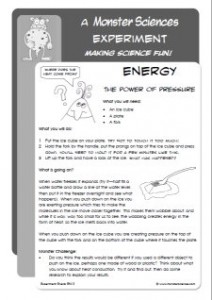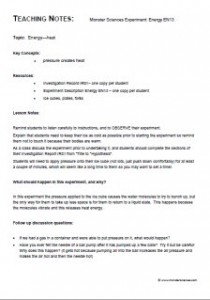Do you know what happens when ice is under pressure? This experiment will show you, and it might surprise you!
 |
 |
An experiment about Energy: Hot ice
What you will need:
- An ice cube
- A plate
- A fork
What you will do:
1 Put the ice cube on your plate. Try not to touch it too much!
2 Hold the fork by the handle, put the prongs on top of the ice cube and press down. You’ll need to hold it for a few minutes like this.
3 Lift up the fork and have a look at the ice. What has happened?
What is going on?
When water freezes it expands (try it—half fill a water bottle and draw a line at the water level, then put it in the freezer overnight and see what happens). When you push down on the ice you are exerting pressure which tries to make the molecules in the ice move closer together. This makes them wobble about, and while it is way, way too small for us to see, the wobbling creates energy in the form of heat, so the ice melts back into water.
When you push down on the ice cube you are creating pressure on the top of the cube with the fork and on the bottom of the cube where it touches the plate.
Monster Challenge:
- Do you think the results would be different if you used a different object to push on the ice, perhaps one made of wood or plastic? Think about what you know about heat conduction. Try it and find out, then do some research to explain your results.
Teaching Notes: Monster Sciences Experiment: Energy EN13
Topic:
Energy—heat
Key Concepts:
Pressure creates heat
Resources:
- Investigation Record IR01– one copy per student
- Experiment Description Energy EN13 – one copy per student
- Ice cubes, plates, forks
Lesson Notes:
Remind students to listen carefully to instructions, and to OBSERVE their experiment.
Explain that students need to keep their ice as cold as possible prior to starting the experiment so remind them not to touch it because their bodies are warm.
As a class discuss the experiment prior to undertaking it, and students should complete the sections of their Investigation Report IR01 from ”Title to “Hypothesis”.
Students will need to apply pressure onto their ice cube (not lots, just push down comfortably) for at least a couple of minutes, which will seem like a long time to them so you may want to set a timer.
What should happen in this experiment, and why?
In this experiment the pressure applied to the ice cube causes the water molecules to try to bunch up, but the only way for them to take up less space is for them to return to a liquid state. This happens because the molecules vibrate and this releases heat energy.
Follow up discussion questions:
- If we had a gas in a container and were able to put pressure on it, what would happen?
- Have you ever felt the needle of a ball pump after it has pumped up a few balls? Try it but be careful! Why does this happen? (it gets hot because pumping air into the ball increases the air pressure and makes the air hot and then the needle hot)



